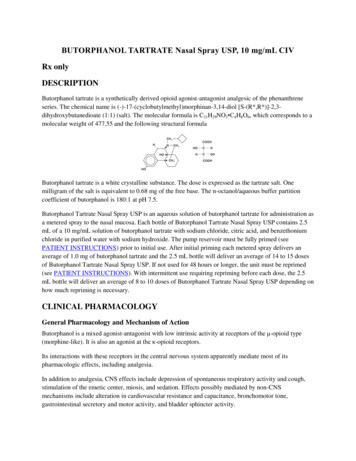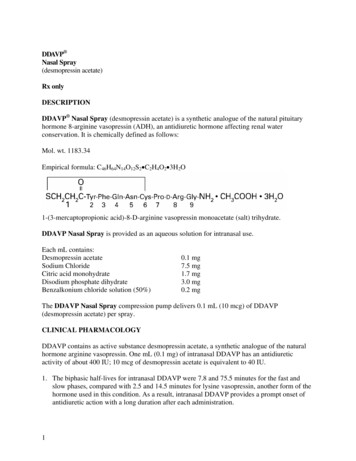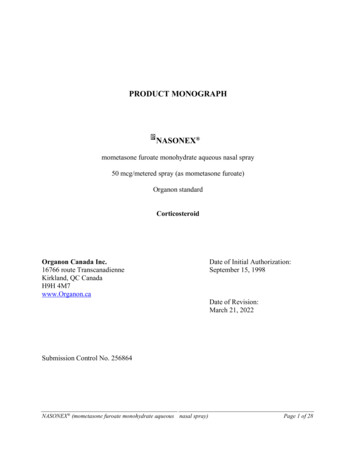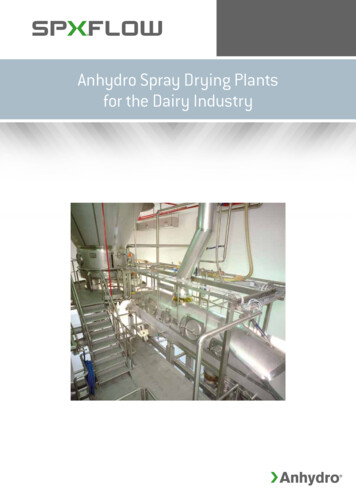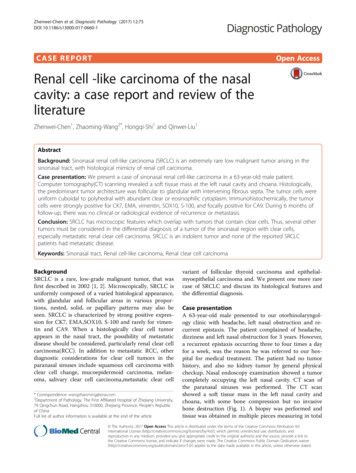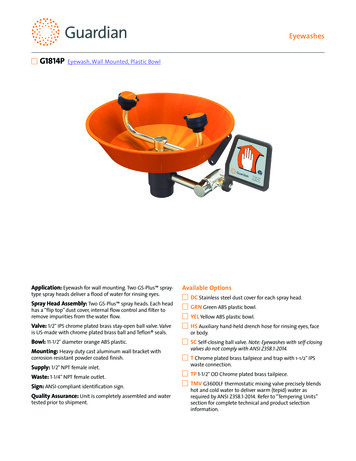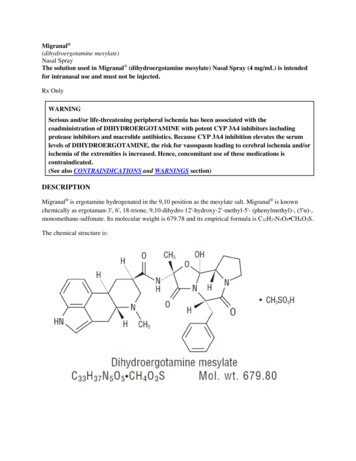
Transcription
Migranal (dihydroergotamine mesylate)Nasal SprayThe solution used in Migranal (dihydroergotamine mesylate) Nasal Spray (4 mg/mL) is intendedfor intranasal use and must not be injected.Rx OnlyWARNINGSerious and/or life-threatening peripheral ischemia has been associated with thecoadministration of DIHYDROERGOTAMINE with potent CYP 3A4 inhibitors includingprotease inhibitors and macrolide antibiotics. Because CYP 3A4 inhibition elevates the serumlevels of DIHYDROERGOTAMINE, the risk for vasospasm leading to cerebral ischemia and/orischemia of the extremities is increased. Hence, concomitant use of these medications iscontraindicated.(See also CONTRAINDICATIONS and WARNINGS section)DESCRIPTIONMigranal is ergotamine hydrogenated in the 9,10 position as the mesylate salt. Migranal is knownchemically as ergotaman-3', 6', 18-trione, 9,10-dihydro-12'-hydroxy-2'-methyl-5'- (phenylmethyl)-, (5'α)-,monomethane-sulfonate. Its molecular weight is 679.78 and its empirical formula is C33H37N5O5 CH4O3S.The chemical structure is:
Migranal (dihydroergotamine mesylate) Nasal Spray is provided for intranasal administration as a clear,colorless to faintly yellow solution in an amber glass vial containing:dihydroergotamine mesylate. .4 mgcaffeine, anhydrous . 10 mgdextrose, anhydrous . 50 mgcarbon dioxide. .qspurified water. . qs 1 mLEach milliliter containsDihydroergotamine mesylate 4 mg(equivalent to 3.43 mg dihydroergotamine)CLINICAL PHARMACOLOGYMechanism of ActionDihydroergotamine binds with high affinity to 5-HT1Dα and 5-HT1Dβ receptors. It also binds with highaffinity to serotonin 5-HT1A, 5-HT2A, and 5-HT2C receptors, noradrenaline α2A, α2B and α1 receptors, anddopamine D2L and D3 receptors.The therapeutic activity of dihydroergotamine in migraine is generally attributed to the agonist effect at 5 HT1D receptors. Two current theories have been proposed to explain the efficacy of 5-HT1D receptoragonists in migraine. One theory suggests that activation of 5-HT1D receptors located on intracranialblood vessels, including those on arterio-venous anastomoses, leads to vasoconstriction, which correlateswith the relief of migraine headache. The alternative hypothesis suggests that activation of 5-HT1Dreceptors on sensory nerve endings of the trigeminal system results in the inhibition of pro-inflammatoryneuropeptide release. In addition, dihydroergotamine possesses oxytocic properties. hydroergotamine mesylate is poorly bioavailable following oral administration. Following intranasaladministration, however, the mean bioavailability of dihydroergotamine mesylate is 32% relative to theinjectable administration. Absorption is variable, probably reflecting both intersubject differences ofabsorption and the technique used for self-administration.DistributionDihydroergotamine mesylate is 93% plasma protein bound. The apparent steady-state volume ofdistribution is approximately 800 liters.MetabolismFour dihydroergotamine mesylate metabolites have been identified in human plasma following oraladministration. The major metabolite, 8'-β-hydroxydihydroergotamine, exhibits affinity equivalent to itsparent for adrenergic and 5-HT receptors and demonstrates equivalent potency in several venoconstrictor
activity models, in vivo and in vitro. The other metabolites, i.e., dihydrolysergic acid, dihydrolysergicamide and a metabolite formed by oxidative opening of the proline ring are of minor importance.Following nasal administration, total metabolites represent only 20%-30% of plasma AUC. The systemicclearance of dihydroergotamine mesylate following I.V. and I.M. administration is 1.5 L/min.Quantitative pharmacokinetic characterization of the four metabolites has not been performed.ExcretionThe major excretory route of dihydroergotamine is via the bile in the feces. After intranasaladministration the urinary recovery of parent drug amounts to about 2% of the administered dosecompared to 6% after I.M. administration. The total body clearance is 1.5 L/min which reflects mainlyhepatic clearance. The renal clearance (0.1 L/min) is unaffected by the route of dihydroergotamineadministration. The decline of plasma dihydroergotamine is biphasic with a terminal half-life of about 10hours.SubpopulationsNo studies have been conducted on the effect of renal or hepatic impairment, gender, race, or ethnicity ondihydroergotamine pharmacokinetics. Migranal (dihydroergotamine mesylate) Nasal Spray iscontraindicated in patients with severely impaired hepatic or renal function. (SeeCONTRAINDICATIONS)InteractionsThe pharmacokinetics of dihydroergotamine did not appear to be significantly affected by theconcomitant use of a local vasoconstrictor (e.g., fenoxazoline).Multiple oral doses of the β-adrenoceptor antagonist propranolol, used for migraine prophylaxis, had nosignificant influence on the Cmax, Tmax or AUC of dihydroergotamine doses up to 4 mg.Pharmacokinetic interactions have been reported in patients treated orally with other ergot alkaloids (e.g.,increased levels of ergotamine) and macrolide antibiotics, principally troleandomycin, presumably due toinhibition of cytochrome P450 3A metabolism of the alkaloids by troleandomycin. Dihydroergotaminehas also been shown to be an inhibitor of cytochrome P450 3A catalyzed reactions and rare reports ofergotism have been obtained from patients treated with dihydroergotamine and macrolide antibiotics (e.g.,troleandomycin, clarithromycin, erythromycin), and in patients treated with dihydroergotamine andprotease inhibitors (e.g. ritonavir), presumably due to inhibition of cytochrome P450 3A metabolism ofergotamine (See CONTRAINDICATIONS). No pharmacokinetic interactions involving other cytochromeP450 isoenzymes are known.Clinical TrialsThe efficacy of Migranal (dihydroergotamine mesylate) Nasal Spray for the acute treatment of migraineheadaches was evaluated in four randomized, double blind, placebo controlled studies in the U.S. Thepatient population for the trials was predominantly female (87%) and Caucasian (95%) with a mean ageof 39 years (range 18 to 65 years). Patients treated a single moderate to severe migraine headache with asingle dose of study medication and assessed pain severity over the 24 hours following treatment.Headache response was determined 0.5, 1, 2, 3 and 4 hours after dosing and was defined as a reduction inheadache severity to mild or no pain. In studies 1 and 2, a four-point pain intensity scale was utilized; in
studies 3 and 4, a five-point scale was used that included both pain response and restoration of functionfor "severe" or "incapacitating" pain, a less clear endpoint. Although rescue medication was allowed in allfour studies, patients were instructed not to use them during the four hour observation period. In studies 3and 4, a total dose of 2 mg was compared to placebo. In studies 1 and 2, doses of 2 and 3 mg wereevaluated, and showed no advantage of the higher dose for a single treatment. In all studies, patientsreceived a regimen consisting of 0.5 mg in each nostril, repeated in 15 minutes (and again in another 15minutes for the 3 mg dose in studies 1 and 2).The percentage of patients achieving headache response 4 hours after treatment was significantly greaterin patients receiving 2 mg doses of Migranal (dihydroergotamine mesylate) Nasal Spray compared tothose receiving placebo in 3 of the 4 studies (see Tables 1 & 2 and Figures 1 & 2).Table 1: Studies 1 and 2: Percentage of patients with headache responsea2 and 4 hours following a single treatment of study medication[Migranal (dihydroergotamine mesylate) Nasal Spray or Placebo]N2 hours4 hours Study 1Migranal10561%**70%**Placebo9823%28% Study 2Migranal10347%56%*Placebo10233%35%aHeadache response was defined as a reduction in headache severity to mild or no pain. Headacheresponse was based on pain intensity as interpreted by the patient using a four-point pain intensity scale.*p value 0.01**p value 0.001Table 2: Studies 3 and 4: Percentage of patients with headache responsea2 and 4 hours following a single treatment of study medication[Migranal (dihydroergotamine mesylate) Nasal Spray or Placebo]N2 hours4 hours Study 3Migranal5032%48%*Placebo5020%22% Study 4Migranal4730%47%Placebo5020%30%aHeadache response was defined as a reduction in headache severity to mild or no pain. Headacheresponse was evaluated on a five-point scale that included both pain response and restoration of functionfor "severe" or "incapacitating" pain.*p value 0.01Comparisons of drug performance based upon results obtained in different clinical trials are neverreliable. Because studies are conducted at different times, with different samples of patients, bydifferent investigators, employing different criteria and/or different interpretations of the samecriteria, under different conditions (dose, dosing regimen, etc.), quantitative estimates of treatmentresponse and the timing of response may be expected to vary considerably from study to study.
The Kaplan-Meier plots below (Figures 1 & 2) provides an estimate of the probability that a patient willhave responded to a single 2 mg dose of Migranal (dihydroergotamine mesylate) Nasal Spray as afunction of the time elapsed since initiation of treatment.*The figure shows the probability over time of obtaining a response following treatment with Migranal (dihydroergotamine mesylate) Nasal Spray. Headache response was based on pain intensity asinterpreted by the patient using a four-point pain intensity scale. Patients not achieving response within4 hours were censored to 4 hours.
*The figure shows the probability over time of obtaining a response following treatment with Migranal (dihydroergotamine mesylate) Nasal Spray. Headache response was evaluated on a five-point scale thatconfounded pain response and restoration of function for "severe" or "incapacitating" pain. Patients notachieving response within 4 hours were censored to 4 hours.For patients with migraine-associated nausea, photophobia, and phonophobia at baseline, there was alower incidence of these symptoms at 2 and 4 hours following administration of Migranal (dihydroergotamine mesylate) Nasal Spray compared to placebo.Patients were not allowed to use additional treatments for eight hours prior to study medication dosingand during the four hour observation period following study treatment. Following the 4 hour observationperiod, patients were allowed to use additional treatments. For all studies, the estimated probability ofpatients using additional treatments for their migraines over the 24 hours following the single 2 mg doseof study treatment is summarized in Figure 3 below.
*Kaplan-Meier plot based on data obtained from all studies with patients not using additional treatmentscensored to 24 hours. All patients received a single treatment of study medication for their migraineattack. The plot also includes patients who had no response to the initial dose.Neither age nor sex appear to effect the patient's response to Migranal (dihydroergotamine mesylate)Nasal Spray. While patients with menstrual migraine, migraine with aura, and migraine without aura bymedical history were included in the clinical evaluation of Migranal (dihydroergotamine mesylate) NasalSpray, patients were not required to report the specific type of migraine treated with study medication.Thus, neither the effect of menses on migraine nor the presence or the absence of aura were assessed. Theracial distribution of patients was insufficient to determine the effect of race on the efficacy of Migranal (dihydroergotamine mesylate) Nasal Spray.INDICATIONS AND USAGEMigranal (dihydroergotamine mesylate) Nasal Spray is indicated for the acute treatment of migraineheadaches with or without aura.Migranal (dihydroergotamine mesylate) Nasal Spray is not intended for the prophylactic therapy ofmigraine or for the management of hemiplegic or basilar migraine.
CONTRAINDICATIONSThere have been a few reports of serious adverse events associated with the coadministration ofdihydroergotamine and potent CYP 3A4 inhibitors, such as protease inhibitors and macrolideantibiotics, resulting in vasospasm that led to cerebral ischemia and/or ischemia of the extremities.The use of potent CYP 3A4 inhibitors (ritonavir, nelfinavir, indinavir, erythromycin,clarithromycin, troleandomycin, ketoconazole, itraconazole) with dihydroergotamine is, thereforecontraindicated (See WARNINGS: CYP 3A4 Inhibitors).Migranal (dihydroergotamine mesylate) Nasal Spray should not be given to patients with ischemicheart disease (angina pectoris, history of myocardial infarction, or documented silent ischemia) orto patients who have clinical symptoms or findings consistent with coronary artery vasospasmincluding Prinzmetal's variant angina. (See WARNINGS)Because Migranal (dihydroergotamine mesylate) Nasal Spray may increase blood pressure, itshould not be given to patients with uncontrolled hypertension.Migranal (dihydroergotamine mesylate) Nasal Spray, 5-HT1 agonists (e.g., sumatriptan),ergotamine-containing or ergot-type medications or methysergide should not be used within 24hours of each other.Migranal (dihydroergotamine mesylate) Nasal Spray should not be administered to patients withhemiplegic or basilar migraine.In addition to those conditions mentioned above, Migranal (dihydroergotamine mesylate) Nasal Spray isalso contraindicated in patients with known peripheral arterial disease, sepsis, following vascular surgery,and severely impaired hepatic or renal function.Migranal (dihydroergotamine mesylate) Nasal Spray may cause fetal harm when administered to apregnant woman. Dihydroergotamine possesses oxytocic properties and, therefore, should not beadministered during pregnancy. If this drug is used during pregnancy, or if the patient becomes pregnantwhile taking this drug, the patient should be apprised of the potential hazard to the fetus.There are no adequate studies of dihydroergotamine in human pregnancy, but developmental toxicity hasbeen demonstrated in experimental animals. In embryofetal development studies of dihydroergotaminemesylate nasal spray, intranasal administration to pregnant rats throughout the period of organogenesisresulted in decreased fetal body weights and/or skeletal ossification at doses of 0.16 mg/day (associatedwith maternal plasma dihydroergotamine exposures [AUC] approximately 0.4 -1.2 times the exposures inhumans receiving the MRDD of 4 mg) or greater. A no effect level for embryo-fetal toxicity was notestablished in rats. Delayed skeletal ossification was also noted in rabbit fetuses following intranasaladministration of 3.6 mg/day (maternal exposures approximately 7 times human exposures at the MRDD)during organogenesis. A no effect level was seen at 1.2 mg/day (maternal exposures approximately 2.5times human exposures at the MRDD). When dihydroergotamine mesylate nasal spray was administeredintranasally to female rats during pregnancy and lactation, decreased body weights and impairedreproductive function (decreased mating indices) were observed in the offspring at doses of 0.16 mg/dayor greater. A no effect level was not established. Effects on development occurred at doses below thosethat produced evidence of significant maternal toxicity in these studies. Dihydroergotamine-induced
intrauterine growth retardation has been attributed to reduced uteroplacental blood flow resulting fromprolonged vasoconstriction of the uterine vessels and/or increased myometrial tone.Migranal (dihydroergotamine mesylate) Nasal Spray is contraindicated in patients who have previouslyshown hypersensitivity to ergot alkaloids.Dihydroergotamine mesylate should not be used by nursing mothers. (See PRECAUTIONS)Dihydroergotamine mesylate should not be used with peripheral and central vasoconstrictors because thecombination may result in additive or synergistic elevation of blood pressure.WARNINGSMigranal (dihydroergotamine mesylate) Nasal Spray should only be used where a clear diagnosisof migraine headache has been established.CYP 3A4 Inhibitors (e.g. Macrolide Antibiotics and Protease Inhibitors)There have been rare reports of serious adverse events in connection with the coadministration ofdihydroergotamine and potent CYP 3A4 inhibitors, such as protease inhibitors and macrolideantibiotics, resulting in vasospasm that led to cerebral ischemia and/or and ischemia of theextremities. The use of potent CYP 3A4 inhibitors with dihydroergotamine should therefore beavoided (See CONTRAINDICATIONS). Examples of some of the more potent CYP 3A4 inhibitorsinclude: antifungals ketoconazole and itraconazole, the protease inhibitors ritonavir, nelfinavir, andindinavir, and macrolide antibiotics erythromycin, clarithromycin, and troleandomycin. Other lesspotent CYP 3A4 inhibitors should be administered with caution. Less potent inhibitors includesaquinavir, nefazodone, fluconazole, grapefruit juice, fluoxetine, fluvoxamine, zileuton, andclotrimazole. These lists are not exhaustive, and the prescriber should consider the effects on CYP3A4 of other agents being considered for concomitant use with dihydroergotamine.Fibrotic ComplicationsThere have been reports of pleural and retroperitoneal fibrosis in patients following prolonged daily useof injectable dihydroergotamine mesylate. Rarely, prolonged daily use of other ergot alkaloid drugs hasbeen associated with cardiac valvular fibrosis. Rare cases have also been reported in association with theuse of injectable dihydroergotamine mesylate; however, in those cases, patients also received drugsknown to be associated with cardiac valvular fibrosis.Administration of Migranal (dihydroergotamine mesylate) Nasal Spray, should not exceed the dosingguidelines and should not be used for chronic daily administration (see DOSAGE ANDADMINISTRATION).Risk of Myocardial Ischemia and/or Infarction and Other Adverse Cardiac Events:Migranal (dihydroergotamine mesylate) Nasal Spray should not be used by patients withdocumented ischemic or vasospastic coronary artery disease. (See CONTRAINDICATIONS) It isstrongly recommended that Migranal (dihydroergotamine mesylate) Nasal Spray not be given topatients in whom unrecognized coronary artery disease (CAD) is predicted by the presence of riskfactors (e.g., hypertension, hypercholesterolemia, smoker, obesity, diabetes, strong family history of
CAD, females who are surgically or physiologically postmenopausal, or males who are over 40years of age) unless a cardiovascular evaluation provides satisfactory clinical evidence that thepatient is reasonably free of coronary artery and ischemic myocardial disease or other significantunderlying cardiovascular disease. The sensitivity of cardiac diagnostic procedures to detectcardiovascular disease or predisposition to coronary artery vasospasm is modest, at best. If, duringthe cardiovascular evaluation, the patient's medical history or electrocardiographic investigationsreveal findings indicative of or consistent with coronary artery vasospasm or myocardial ischemia,Migranal (dihydroergotamine mesylate) Nasal Spray should not be administered. (SeeCONTRAINDICATIONS)For patients with risk factors predictive of CAD who are determined to have a satisfactorycardiovascular evaluation, it is strongly recommended that administration of the first dose ofMigranal (dihydroergotamine mesylate) Nasal Spray take place in the setting of a physician'soffice or similar medically staffed and equipped facility unless the patient has previously receiveddihydroergotamine mesylate. Because cardiac ischemia can occur in the absence of clinicalsymptoms, consideration should be given to obtaining on the first occasion of use anelectrocardiogram (ECG) during the interval immediately following Migranal (dihydroergotaminemesylate) Nasal Spray, in these patients with risk factors.It is recommended that patients who are intermittent long-term users of Migranal (dihydroergotamine mesylate) Nasal Spray and who have or acquire risk factors predictive of CAD,as described above, undergo periodic interval cardiovascular evaluation as they continue to useMigranal (dihydroergotamine mesylate) Nasal Spray.The systematic approach described above is currently recommended as a method to identifypatients in whom Migranal (dihydroergotamine mesylate) Nasal Spray may be used to treatmigraine headaches with an acceptable margin of cardiovascular safety.Cardiac Events and FatalitiesNo deaths have been reported in patients using Migranal (dihydroergotamine mesylate) Nasal Spray.However, the potential for adverse cardiac events exists. Serious adverse cardiac events, including acutemyocardial infarction, life-threatening disturbances of cardiac rhythm, and death have been reported tohave occurred following the administration of dihydroergotamine mesylate injection (e.g., D.H.E. 45 Injection). Considering the extent of use of dihydroergotamine mesylate in patients with migraine, theincidence of these events is extremely low.Drug-Associated Cerebrovascular Events and FatalitiesCerebral hemorrhage, subarachnoid hemorrhage, stroke, and other cerebrovascular events have beenreported in patients treated with D.H.E. 45 Injection; and some have resulted in fatalities. In a number ofcases, it appears possible that the cerebrovascular events were primary, the D.H.E. 45 Injection havingbeen administered in the incorrect belief that the symptoms experienced were a consequence of migraine,when they were not. It should be noted that patients with migraine may be at increased risk of certaincerebrovascular events (e.g., stroke, hemorrhage, transient ischemic attack).
Other Vasospasm Related EventsMigranal (dihydroergotamine mesylate) Nasal Spray, like other ergot alkaloids, may cause vasospasticreactions other than coronary artery vasospasm. Myocardial and peripheral vascular ischemia have beenreported with Migranal (dihydroergotamine mesylate) Nasal Spray.Migranal (dihydroergotamine mesylate) Nasal Spray associated vasospastic phenomena may also causemuscle pains, numbness, coldness, pallor, and cyanosis of the digits. In patients with compromisedcirculation, persistent vasospasm may result in gangrene or death, Migranal (dihydroergotaminemesylate) Nasal Spray should be discontinued immediately if signs or symptoms of vasoconstrictiondevelop.Increase in Blood PressureSignificant elevation in blood pressure has been reported on rare occasions in patients with and without ahistory of hypertension treated with Migranal (dihydroergotamine mesylate) Nasal Spray anddihydroergotamine mesylate injection. Migranal (dihydroergotamine mesylate) Nasal Spray iscontraindicated in patients with uncontrolled hypertension. (See CONTRAINDICATIONS)An 18% increase in mean pulmonary artery pressure was seen following dosing with another 5HT1agonist in a study evaluating subjects undergoing cardiac catheterization.Local IrritationApproximately 30% of patients using Migranal (dihydroergotamine mesylate) Nasal Spray (compared to9% of placebo patients) have reported irritation in the nose, throat, and/or disturbances in taste. Irritativesymptoms include congestion, burning sensation, dryness, paraesthesia, discharge, epistaxis, pain, orsoreness. The symptoms were predominantly mild to moderate in severity and transient. In approximately70% of the above mentioned cases, the symptoms resolved within four hours after dosing with Migranal (dihydroergotamine mesylate) Nasal Spray. Examinations of the nose and throat in a small subset (N 66) of study participants treated for up to 36 months (range 1-36 months) did not reveal any clinicallynoticeable injury. Other than this limited number of patients, the consequences of extended and repeateduse of Migranal (dihydroergotamine mesylate) Nasal Spray on the nasal and/or respiratory mucosa havenot been systematically evaluated in patients.Nasal tissue in animals treated with dihydroergotamine mesylate daily at nasal cavity surface areaexposures (in mg/mm2) that were equal to or less than those achieved in humans receiving the maximumrecommended daily dose of 0.08 mg/kg/day showed mild mucosal irritation characterized by mucous celland transitional cell hyperplasia and squamous cell metaplasia. Changes in rat nasal mucosa at 64 weekswere less severe than at 13 weeks. Local effects on respiratory tissue after chronic intranasal dosing inanimals have not been evaluated.PRECAUTIONSGeneralMigranal (dihydroergotamine mesylate) Nasal Spray may cause coronary artery vasospasm; patientswho experience signs or symptoms suggestive of angina following its administration should, therefore, beevaluated for the presence of CAD or a predisposition to variant angina before receiving additional doses.
Similarly, patients who experience other symptoms or signs suggestive of decreased arterial flow, such asischemic bowel syndrome or Raynaud's syndrome following the use of any 5-HT agonist are candidatesfor further evaluation. (See WARNINGS).Fibrotic Complications: see WARNINGS: Fibrotic ComplicationsInformation for PatientsThe text of a patient information sheet is printed at the end of this insert. To assure safe and effective useof Migranal (dihydroergotamine mesylate) Nasal Spray, the information and instructions provided in thepatient information sheet should be discussed with patients.Once the nasal spray applicator has been prepared, it should be discarded (with any remaining drug) after8 hours.Patients should be advised to report to the physician immediately any of the following: numbness ortingling in the fingers and toes, muscle pain in the arms and legs, weakness in the legs, pain in the chest,temporary speeding or slowing of the heart rate, swelling, or itching.Prior to the initial use of the product by a patient, the prescriber should take steps to ensure that thepatient understands how to use the product as provided. (See Patient Information Sheet and productpackaging).Administration of Migranal (dihydroergotamine mesylate) Nasal Spray, should not exceed the dosingguidelines and should not be used for chronic daily administration (see DOSAGE ANDADMINISTRATION).Drug InteractionsVasoconstrictorsMigranal (dihydroergotamine mesylate) Nasal Spray should not be used with peripheral vasoconstrictorsbecause the combination may cause synergistic elevation of blood pressure.SumatriptanSumatriptan has been reported to cause coronary artery vasospasm, and its effect could be additive withMigranal (dihydroergotamine mesylate) Nasal Spray. Sumatriptan and Migranal (dihydroergotaminemesylate) Nasal Spray should not be taken within 24 hours of each other. (See CONTRAINDICATIONS)Beta BlockersAlthough the results of a clinical study did not indicate a safety problem associated with theadministration of Migranal (dihydroergotamine mesylate) Nasal Spray to subjects already receivingpropranolol, there have been reports that propranolol may potentiate the vasoconstrictive action ofergotamine by blocking the vasodilating property of epinephrine.
NicotineNicotine may provoke vasoconstriction in some patients, predisposing to a greater ischemic response toergot therapy.CYP 3A4 Inhibitors (e.g. Macrolide Antibiotics and Protease Inhibitors)See CONTRAINDICATIONS and WARNINGS.SSRI'sWeakness, hyperreflexia, and incoordination have been reported rarely when 5HT1 agonists have beencoadministered with SSRI's (e.g., fluoxetine, fluvoxamine, paroxetine, sertraline). There have been noreported cases from spontaneous reports of drug interaction between SSRI's and Migranal (dihydroergotamine mesylate) Nasal Spray or D.H.E. 45 .Oral ContraceptivesThe effect of oral contraceptives on the pharmacokinetics of Migranal (dihydroergotamine mesylate)Nasal Spray has not been studied.Carcinogenesis, Mutagenesis, Impairment of FertilityCarcinogenesisAssessment of the carcinogenic potential of dihydroergotamine mesylate in mice and rats is ongoing.MutagenesisDihydroergotamine mesylate was clastogenic in two in vitro chromosomal aberration assays, the V79Chinese hamster cell assay with metabolic activation and the cultured human peripheral bloodlymphocyte assay. There was no evidence of mutagenic potential when dihydroergotamine mesylate wastested in the presence or absence of metabolic activation in two gene mutation assays (the Ames test andthe in vitro mammalian Chinese hamster V79/HGPRT assay) and in an assay for DNA damage (the rathepatocyte unscheduled DNA synthesis test). Dihydroergotamine was not clastogenic in the in vivomouse and hamster micronucleus tests.Impairment of FertilityThere was no evidence of impairment of fertility in rats given intranasal doses of Migranal (dihydroergotamine mesylate) Nasal Spray up to 1.6 mg/day (associated with mean plasmadihydroergotamine mesylate exposures [AUC] approximately 9 to 11 times those in humans receiving theMRDD of 4 mg).PregnancyPregnancy Category X. See CONTRAINDICATIONS.Nursing MothersErgot drugs are known to inhibit prolactin. It is likely that Migranal (dihydroergotamine mesylate) NasalSpray is excreted in human milk, but there are no data on the concentration of dihydroergotamine in
human milk. It is known that ergotamine is excreted in breast milk and may cause vomiting, diarrhea,weak pulse, and unstable blood pressure in nursing infants. Because of the potential for these seriousadverse events in nursing infants exposed to Migranal (dihy
Nasal Spray . The solution used in Migranal (dihydroergotamine mesylate) Nasal Spray (4 mg/mL) is intended for intranasal use and must not be injected. Rx Only . WARNING Serious and/or life-threatening peripheral ischemia has been associated with the coadministration of DIHYDROERGOTAMINE with potent CYP 3A4 inhibitors including
